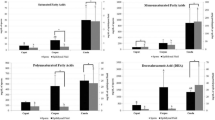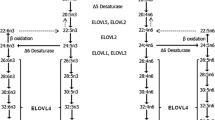Abstract
Cryopreservation of kangaroo sperm has not been successful so far, and yet there is no promising cryopreservation protocol for these cells available. However, conservation of gametes is extremely important, particularly in the context of preserving endangered species. As spermatozoa are comprised of different membrane systems, the composition of these membranes might account for difficulties in cryopreservation. Lipids, as the main components, affect the physical properties of biological membranes and play a major role in sperm maturation. Therefore, knowledge of the lipid composition is crucial for any further step toward the preservation of the species. We used MALDI-TOF, ESI-IT, tandem mass spectrometry, and thin layer chromatography to investigate the lipid composition of epididymal spermatozoa of four different kangaroo species. Spectra of these species were very similar with respect to the identified lipid species. Tremendous changes in the lipid composition during the transit of sperm from caput to cauda epididymis could be seen, specifically an increase in poly-unsaturated fatty acids, ether lipids, and plasmalogens, as well as a reduction in mono- and di-unsaturated fatty acids. Additionally, phosphatidylcholines containing docosatrienoic acid (22:3), a heretofore unknown fatty acid for sperm membranes, showed the highest abundance in kangaroo sperm.





Similar content being viewed by others
Abbreviations
- CerPCho:
-
Sphingomyelin
- CID:
-
Collision-induced dissociation
- DHB:
-
2,5-Dihydroxybenzoic acid
- DMA:
-
Dimethylacetamide
- ESI-IT MS:
-
Electrospray ionization ion trap mass spectrometry
- FAME:
-
Fatty acid methyl esters
- GC:
-
Gas chromatography
- HPTLC:
-
High-performance thin-layer chromatography
- MALDI-TOF MS:
-
Matrix-assisted laser desorption/ionization time-of-flight mass spectrometry
- MS/MS:
-
Tandem mass spectrometry
- n-3/-6/-9:
-
Omega-3/-6/-9 fatty acid
- PBS:
-
Phosphate-buffered saline
- PLA2 :
-
Phospholipase A2
- PakCho:
-
1-O-Alkyl-2-acyl-sn-glycero-3-phosphocholine
- PlsCho:
-
1-O-Alkenyl-2-acyl-sn-glycero-3-phosphocholine
- PtdCho:
-
1,2-Diacyl-sn-glycero-3-phosphocholine
- PakEtn:
-
1-O-Alkyl-2-acyl-sn-glycero-3-phosphoethanolamine
- PtdEtn:
-
1,2-Diacyl-sn-glycero-3-phosphoethanolamine
- PtdIns:
-
1,2-Diacyl-sn-glycero-3-phosphoinositol
- ROS:
-
Reactive oxygen species
- TLC:
-
Thin-layer chromatography
- UV:
-
Ultraviolet
References
Rodger JC, Hughes RL (1973) Studies of the accessory glands of male marsupials. Aust J Zool 21(3):303. doi:10.1071/ZO9730303
Rodger JC, White IG (1975) Electroejaculation of Australian marsupials and analyses of the sugars in the seminal plasma from three macropod species. J Reprod Fertil 43(2):233–239
White IG (1993) Lipids and calcium uptake of sperm in relation to cold shock and preservation: a review. Reprod Fertil Dev 5(6):639. doi:10.1071/RD9930639
Scarlett CJ, Lin M, Aitken RJ (2001) Actin polymerisation during morphogenesis of the acrosome as spermatozoa undergo epididymal maturation in the tammar wallaby (Macropus eugenii). J Anat 198(1):93–101. doi:10.1046/j.1469-7580.2001.19810093.x
Lessig J, Gey C, Suss R et al (2004) Analysis of the lipid composition of human and boar spermatozoa by MALDI-TOF mass spectrometry, thin layer chromatography and 31P NMR spectroscopy. Comp Biochem Physiol B Biochem Mol Biol 137(2):265–277. doi:10.1016/j.cbpc.2003.12.001
Fuchs B, Jakop U, Goritz F et al (2009) MALDI-TOF “fingerprint” phospholipid mass spectra allow the differentiation between ruminantia and feloideae spermatozoa. Theriogenology 71(4):568–575. doi:10.1016/j.theriogenology.2008.08.023
Fuchs B, Muller K, Goritz F et al (2007) Characteristic oxidation products of choline plasmalogens are detectable in cattle and roe deer spermatozoa by MALDI-TOF mass spectrometry. Lipids 42(11):991–998. doi:10.1007/s11745-007-3108-7
Fuchs B, Suss R, Schiller J (2010) An update of MALDI-TOF mass spectrometry in lipid research. Prog Lipid Res 49(4):450–475. doi:10.1016/j.plipres.2010.07.001
Pulfer M, Murphy RC (2003) Electrospray mass spectrometry of phospholipids. Mass Spectrom Rev 22(5):332–364. doi:10.1002/mas.10061
Bligh EG, Dyer WJ (1959) A rapid method of total lipid extraction and purification. Can J Biochem Physiol 37(8):911–917. doi:10.1139/o59-099
White T, Bursten S, Federighi D et al (1998) High-resolution separation and quantification of neutral lipid and phospholipid species in mammalian cells and sera by multi-one-dimensional thin-layer chromatography. Anal Biochem 258(1):109–117. doi:10.1006/abio.1997.2545
Schiller J, Arnhold J, Benard S et al (1999) Lipid analysis by matrix-assisted laser desorption and ionization mass spectrometry: a methodological approach. Anal Biochem 267(1):46–56. doi:10.1006/abio.1998.3001
Popkova Y, Schiller J (2017) Addition of CsCl reduces ion suppression effects in the matrix-assisted laser desorption/ionization mass spectra of triacylglycerol/phosphatidylcholine mixtures and adipose tissue extracts. Rapid Commun Mass Spectrom 31(5):411–418. doi:10.1002/rcm.7806
Milne S, Ivanova P, Forrester J et al (2006) Lipidomics: an analysis of cellular lipids by ESI-MS. Methods 39(2):92–103. doi:10.1016/j.ymeth.2006.05.014
Dannenberger D, Nuernberg K, Nuernberg G et al (2012) Different dietary protein and PUFA interventions alter the fatty acid concentrations, but not the meat quality, of porcine muscle. Nutrients 4(9):1237–1246. doi:10.3390/nu4091237
Angulo J, Hiller B, Olivera M et al (2012) Dietary fatty acid intervention of lactating cows simultaneously affects lipid profiles of meat and milk. J Sci Food Agric 92(15):2968–2974. doi:10.1002/jsfa.5709
Schiller J, Müller K, Süß R et al (2003) Analysis of the lipid composition of bull spermatozoa by MALDI-TOF mass spectrometry—a cautionary note. Chem Phys Lipids 126(1):85–94. doi:10.1016/S0009-3084(03)00097-5
Schneiter R, Brugger B, Sandhoff R et al (1999) Electrospray ionization tandem mass spectrometry (ESI-MS/MS) analysis of the lipid molecular species composition of yeast subcellular membranes reveals acyl chain-based sorting/remodeling of distinct molecular species en route to the plasma membrane. J Cell Biol 146(4):741–754
Comizzoli P (2015) Biobanking efforts and new advances in male fertility preservation for rare and endangered species. Asian J Androl 17(4):640–645. doi:10.4103/1008-682X.153849
Walters EM, Men H, Agca Y et al (2005) Osmotic tolerance of mouse spermatozoa from various genetic backgrounds: acrosome integrity, membrane integrity, and maintenance of motility. Cryobiology 50(2):193–205. doi:10.1016/j.cryobiol.2005.01.004
McClean RV, Holt WV, Johnston SD (2007) Ultrastructural observations of cryoinjury in kangaroo spermatozoa. Cryobiology 54(3):271–280. doi:10.1016/j.cryobiol.2007.03.004
Garcia BM, Ferrusola CO, Aparicio IM et al (2012) Toxicity of glycerol for the stallion spermatozoa: effects on membrane integrity and cytoskeleton, lipid peroxidation and mitochondrial membrane potential. Theriogenology 77(7):1280–1289. doi:10.1016/j.theriogenology.2011.10.033
McClean R, MacCallum C, Blyde D et al (2006) Actin localisation and the effect of cytochalasin D on the osmotic tolerance of cauda epididymidal kangaroo spermatozoa. CryoLetters 27(4):253–260
Lin M, Rodger JC (1999) Acrosome formation during sperm transit through the epididymis in two marsupials, the tammar wallaby (Macropus eugenii) and the brushtail possum (Trichosurus vulpecula). J Anat 194(2):223–232. doi:10.1046/j.1469-7580.1999.19420223.x
McClean R, Zee YP, Holt WV et al (2008) Cryopreservation of kangaroo spermatozoa using alternative approaches that reduce cytotoxic exposure to glycerol. Cryobiology 57(3):304–307. doi:10.1016/j.cryobiol.2008.08.007
Miller RR, Sheffer CJ, Cornett CL et al (2004) Sperm membrane fatty acid composition in the Eastern grey kangaroo (Macropus giganteus), koala (Phascolarctos cinereus), and common wombat (Vombatus ursinus) and its relationship to cold shock injury and cryopreservation success. Cryobiology 49(2):137–148. doi:10.1016/j.cryobiol.2004.06.002
Darin-Bennett A, Poulos A, White IG (1974) The phospholipids and phospholipid-bound fatty acids and aldehydes of dog and fowl spermatozoa. Reproduction 41(2):471–474. doi:10.1530/jrf.0.0410471
Ravie O, Lake PE (1985) The phospholipid-bound fatty acids of fowl and turkey spermatozoa. Anim Reprod Sci 9(2):189–192. doi:10.1016/0378-4320(85)90023-5
Aveldaño MI, Rotstein NP, Vermouth NT (1992) Occurrence of long and very long polyenoic fatty acids of the n-9 series in rat spermatozoa. Lipids 27(9):676–680. doi:10.1007/BF02536023
Saether T, Tran TN, Rootwelt H et al (2007) Essential fatty acid deficiency induces fatty acid desaturase expression in rat epididymis, but not in testis. Reproduction 133(2):467–477. doi:10.1530/REP-06-00294
Pyttel S, Nimptsch A, Bottger J et al (2014) Changes of murine sperm phospholipid composition during epididymal maturation determined by MALDI-TOF mass spectrometry. Theriogenology 82(3):396–402. doi:10.1016/j.theriogenology.2014.04.017
Sato D, Ando Y, Tsujimoto R et al (2001) Identification of novel nonmethylene-interrupted fatty acids, 7E, 13E-20:2, 7E, 13E, 17Z-20:3, 9E, 15E, 19Z-22:3, and 4Z, 9E, 15E, 19Z-22:4, in Ophiuroidea (brittle star) lipids. Lipids 36(12):1371–1375
Palmer DN, Husbands DR, Jolly RD (1985) Phospholipid fatty acids in brains of normal sheep and sheep with ceroid-lipofuscinosis. Biochim Biophys Acta 834(2):159–163
Nervi AM, Brenner RR (1965) Identification and origin of docosatrienoic acid of rat phospholipids. Biochim Biophys Acta 106(1):205–207
Parks JE, Hammerstedt RH (1985) Development changes occurring in the lipids of ram epididymal spermatozoa plasma membrane. Biol Reprod 32(3):653–668
Banerjee N, Rosenthal MD (1986) Elongation of C20 polyunsaturated fatty acids by human skin fibroblasts. Biochim et Biophys Acta (BBA) Lipids Lipid Metab 878(3):404–411. doi:10.1016/0005-2760(86)90249-3
Brenner RR (1974) The oxidative desaturation of unsaturated fatty acids in animals. Mol Cell Biochem 3(1):41–52. doi:10.1007/BF01660076
Godwin S, Kang A, Gulino L et al (2014) Investigation of the microbial metabolism of carbon dioxide and hydrogen in the kangaroo foregut by stable isotope probing. ISME J 8(9):1855–1865. doi:10.1038/ismej.2014.25
Zoeller RA, Lake AC, Nagan N et al (1999) Plasmalogens as endogenous antioxidants: somatic cell mutants reveal the importance of the vinyl ether. Biochem J 338(3):769–776. doi:10.1042/bj3380769
Yeste M (2015) Recent advances in boar sperm cryopreservation: state of the art and current perspectives. Reprod Domest Anim 50(Suppl 2):71–79. doi:10.1111/rda.12569
Acknowledgements
The authors would like to thank Dr. Gudrun Wibbelt for the necropsy of the analyzed animals and the provision of kangaroo testes and epididymides and Christiane Franz for technical assistance. This work was supported by the German Research Council (DFG Schi 476/12-2, DFG Schi 476/16-1, DFG MU 1520/4-2 and SFB 1052/Z3).
Author information
Authors and Affiliations
Contributions
Conception and design, Analysis and interpretation of the data, Drafting of the article, Critical revision of the article for important intellectual content, Final approval of the article: KME, UJ, KM, JS.
Corresponding author
Electronic supplementary material
Below is the link to the electronic supplementary material.
About this article
Cite this article
Engel, K.M., Schiller, J., Müller, K. et al. The Phospholipid Composition of Kangaroo Spermatozoa Verified by Mass Spectrometric Lipid Analysis. Lipids 52, 857–869 (2017). https://doi.org/10.1007/s11745-017-4283-9
Received:
Accepted:
Published:
Issue Date:
DOI: https://doi.org/10.1007/s11745-017-4283-9




